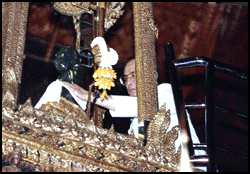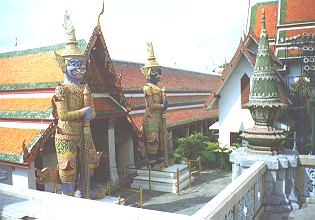
His Majesty replaces the Emerald Buddha's summer costume with that for the rainy season"

Wat Phra Si Rattanasatsadaram from the northeast

Mural painting of the Gallery or Phra Rabiang inside an entrance to the Grand Palace
|
|
Wat Phra Si Rattanasatsadaram, commonly called the Temple of the Emerald Buddha, was built early in the reign of King Rama I, founder of the
Chakri Dynasty, who established Rattanakosin (Bangkok) as the capital of Kingdom in A.D. 1782.
The new temple was completed in A.D. 1784. This royal chapel occupies its own compound within the Grand Palace as Wat Phra Si Sanphet in the former capital, Ayutthaya. It is the most revered temple in the city,
but being the Royal Chapel no monks reside there. It serves as the centre for all religious rites pertaining to the State and Monarchy, such as ordina tions under royal patronage, special ecclesiatical rites, and the swearing of fealty.
King Rama I brought the image of the Emerald Buddha, which is regarded by the Thai people as the palladium of the Kingdom, from the palace in Thon Buri the former capital on the west bend of the Chao Phraya River,
to the Main Assembly Hall of the newly-built Royal Chapel where it has remained ever since.
During its two hundred years's history, the Chapel has undergone several renovations, restorations and additions to its edifices. Extensive restoration and additional construction were carried out in the reigns of
King Rama III (A.D. 1824-1851) and King Rama IV A.D. 1851-1868). in time for the Bangkok Centennial celebrations
in 1882. The Royal Chapel thus incorporates no less than two centuries of Rattanakosin craftsmanship and artistic ingenuity which are, in themselves, an expression of the essential entity of the Thai people
|







